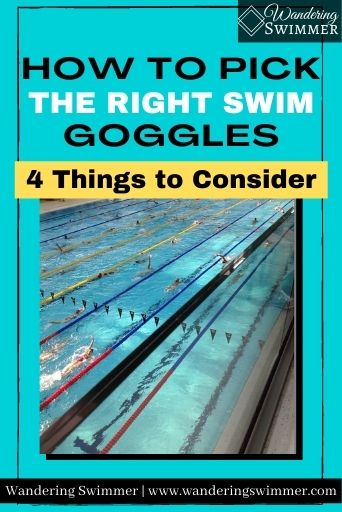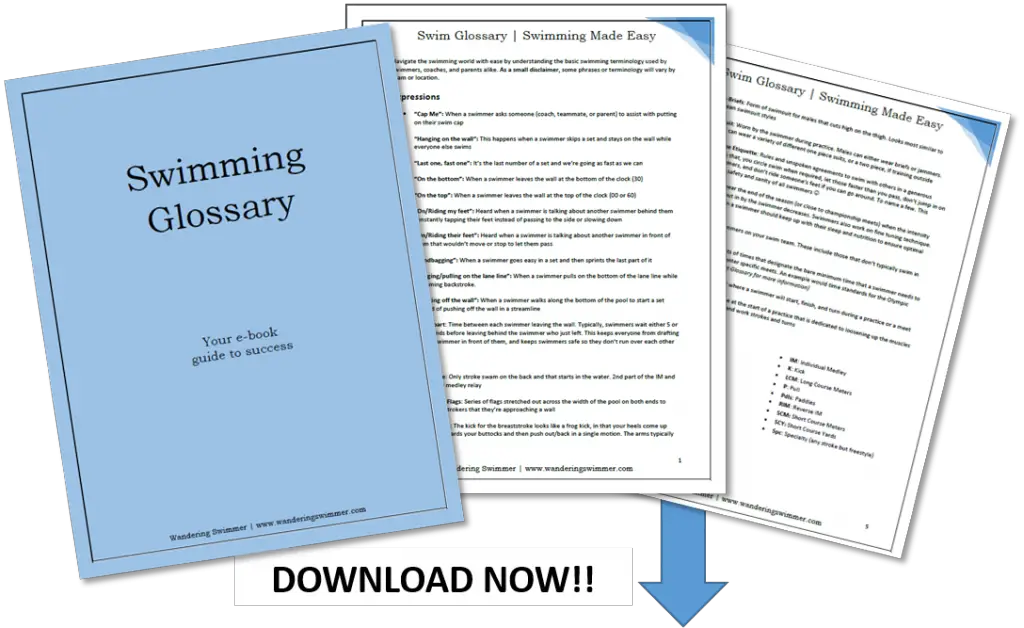When it comes time to pick the right swim goggles, you might feel overwhelmed with the vast options available. But there are a few things to keep in mind as you try to pick your next set of goggles.
We will note that every swimmer has their favorite type of goggles. And what works for them, might not work for you. Finding the goggle that works best for you ultimately comes down to your preference.
Related articles:
Lastly, it’s a matter of trial and error. We encourage you to be patient in your search and talk to others about different options.
Disclosure: This post may contain affiliate links, meaning we earn a small commission at no cost to you if you purchase something through one of our links. As an Amazon Associate, we earn from qualifying purchases. Please check out our disclosure page for more information.

What Are Your Swimming Needs?
To start finding the right swim goggles, you need to know what your swimming needs are first.
And what you’re wanting your goggles to accomplish for you.
- Will you be racing in these goggles? Or are you just training?
- What size lens are you looking for?
- Is comfort a key factor?
- Are you swimming primarily inside or outside?
- Are you training for open water or a triathlon?
Once you start identifying what you need in a goggle, you can start narrowing down the ones that might work best for you. 🙂
Some Things to Consider
1. Comfort
Goggles come in all shapes and sizes.
Some will fit close to the eye and sit right in the eye socket (or orbital bone), such as Swedish goggles. While others tend to fit wider over the eyes for a more comfortable fit. Such as FINIS Energy Goggle
And then you have those that are somewhere in between. 🙂
A good breakdown would be as follows, from least to most comfortable. Again, in our opinion 😉
- Close to the Eye: Are typically referred to as Swedish goggles. They sit right in the orbital bone and have no seal around the goggle. Best recommended for competitive or advanced level swimmers. Can also be used for racing.
- Middle Eye: One of the more popular styles of goggles. They sit on the orbital bone (just below your eyebrow) and have a seal to create a good seal. Most sit close to the face for speed and reduced drag. These can be worn for long workouts. Best recommended for recreation and lap swimming, swim practice, and racing. Can be used by open water swimmers, but the viewing field is limited
- Wider Fit Around the Eye: More comfortable fit than goggles that fit in the first two options. The seal sits further off the orbital bone for a better, more comfortable seal. Best recommended for recreation and lap swimming. Also good for younger and older swimmers, due to comfort
- Mask: Typically used for recreation and open water swimmers. The large area forms a tight seal and the wider lens extends the peripheral vision. Best recommended for open water swimmers
2. Tint Type
When it comes to the goggle tint, goggles come in four different types:
- Clear
- Tinted
- Mirrored
- Polarized
Some of these goggles can be used in an outdoor or indoor setting, based on the lighting.
But for the most part, you’ll find that clear and some tinted goggles are best for indoor settings. And some tinted, mirrored, and polarized are best for outdoor swimming.
More Content for You: How to Select the Best Fin Socks
However, it’s worth noting that goggle preference comes down to each swimmer.
Some swimmers compete indoors with dark mirrored goggles. While others like to swim outdoors with clear goggles. Keep this in mind when looking at the various goggles.
- Indoor Swimming: Clear or lightly tinted goggles are best. Some mirrored goggles can be used indoors if they’re a lighter color
- Outdoor Swimming: Consider tinted, mirrored, or polarized goggles. We recommend darker colored goggles to help with the sun. Most mirrored goggles have UV protection to help protect your eyes
- Open Water (cloudy days or early/late swims): If you’ll be swimming in low light, such as early morning, late evenings, or cloudy days, opt for a more clear lens. These will help you see better in the dim lighting
- Open Water (Sunny and bright swims): On sunny days, consider goggles that have dark tints or are mirrored to help reduce any glare
3. Lens Size for Viewing
The lens of a goggle determines how much a swimmer can see. And goggle lenses come in various sizes.
The larger the lens, the more a swimmer’s peripheral vision increases. Whereas smaller lenses narrow what a swimmer can see.
Related article: What Equipment Do You Need to Start Lap Swimming?
Most of the time, goggles with larger lenses and wider peripheral vision are best for open water swimmers. The extended view gives them the best view for sighting and spotting.
Competitive swimmers tend to opt for smaller (close to the eye and middle eye) goggles. Both for practice and racing.
If you’re swimming laps, a middle eye or wider fit goggles may work well for you.
Again, the lens size comes down to your personal preference. And it’s hard to say exactly what you’ll like without trying something first.
Start with what you think or know you’ll need and adjust from there 🙂
4. Age
Most goggle brands come with goggles that are specific for adults and kids.
Those that are designed for kids will usually be labeled as ‘Jr.’ or ‘Youth’. Some will be padded a bit more around the lenses for more comfort. And oftentimes, they’re designed for a child’s face.
In short, they’re smaller in size.
We say this because goggles that are too big for a child will likely fall off. Or leak/fill up with water.
More Content for You: The Best 11 Kickboards for Swimming
And goggles that are too small for an adult will cause discomfort and/or leaking.
That said, always check the goggle label to ensure what age it’s for.
Goggle Summary
Still not sure about the right swim goggles for you? We’ve compiled a quick summary for you based on the type of swimming that you might be doing.
Swim Practice, Lap Swimming, and Recreation
Most goggles are well suited for any type of swimming, from practice to recreation. Even though goggles might be marketed as ‘competition goggles’ they’re still great for casual swimming or swim practice.
Speedo Vanquishers and Sporti Antifog Goggles are two of the most popular goggles at the pool. I’m personally a fan of Arena Tracks for both swim practice and meets.
More Content for You: Swim Etiquette: 15 Ways to Share the Pool
These goggles tend to be a bit smaller around the eye socket (or orbital bone) and for some, this can be uncomfortable.
For goggles that are designed for a wider fit around the orbital bone, consider Speedo Hydrospex Classic goggles. Most goggles from Aqua Sphere fit more wide around the eyes for more comfort.
Racing/Competition
Goggles made for racing in the pool typically fit close to the face. And they can potentially fit
Arena’s Cobra Swipe and Speedo’s Speed Socket are best suited for competition by competitive swimmers. They have a lower profile that makes them less likely to fall off on a dive and help reduce drag.
Related article: Top 11 Questions About Swim Meets
While you can wear them for recreation, they are more expensive than most goggles.
Swedish goggles are also seen at swim meets. They’re small, sleek, and minimalistic for reduced drag. However, they’re more likely to fall off at a start if you haven’t mastered diving in with them.
Open Water
Swimming in open water is a bit different from swimming in a pool. Open water swimmers need to sight numerous times during a swim. And water conditions are less clear than that in the pool.
Look for goggles with the following:
- Extended peripheral vision with wider lenses to help better orient yourself
- Sit wider over the eyes for a more comfortable fit.
- Seals are made from a softer material
- Excellent anti-fog coating
- Tint options for the outdoor weather/water conditions
Aqua Sphere has great options for open water goggles. Their Kayenne Goggles line come in several different varieties to suit your needs
One final note about open water swimming. Please be sure you’re taking safety precautions when swimming.
- Wear a wetsuit, neoprene cap, gloves, and socks as weather and water conditions apply.
- Always wear a brightly colored cap
- Use an open water swim buoy
- Swim with a partner or group when you can
- Always let someone know when you’re swimming and your location/route
Having a good open water swim isn’t just about the best goggles. It’s about being safe and smart, too 🙂
As always, happy swimming!
Chevron
Bonus Content
A Swimmer’s Review of the YYST Swim Bungee: Swimming at home in your backyard pool is possible by using a swim bungee. For swimmers of any level, the YYST Swim Bungee is affordable and easy to use.
Best Gear for Swimmers Returning to the Pool: Returning to the pool? Chances are that you’ll need to replace some gear. Here are 7 pieces of gear for swimmers returning to the pool.

Want to Improve at the Pool?
Join swimmers and swim parents to receive my free newsletter and receive a free Swimming Glossary e-book as a thanks!
Every month you’ll receive tips and coaching to help you find success at the pool.